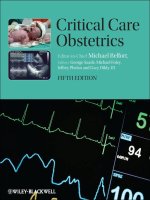The Intensive Care Manual - part 1 pdf
Bạn đang xem bản rút gọn của tài liệu. Xem và tải ngay bản đầy đủ của tài liệu tại đây (429.28 KB, 42 trang )
This page intentionally left blank.
The
Intensive Care
Manual
fm01.qxd 11/7/01 4:07 PM Page i
NOTICE
Medicine is an ever-changing science. As new research and clinical experience broaden
our knowledge, changes in treatment and drug therapy are required. The editors and
the publisher of this work have checked with sources believed to be reliable in their ef-
forts to provide information that is complete and generally in accord with the stan-
dards accepted at the time of publication. However, in view of the possibility of
human error or changes in medical sciences, neither the editors nor the publisher nor
any other party who has been involved in the preparation or publication of this work
warrants that the information contained herein is in every respect accurate or com-
plete, and they are not responsible for any errors or omissions or for the results ob-
tained from use of such information. Readers are encouraged to confirm the
information contained herein with other sources. For example and in particular, read-
ers are advised to check the product information sheet included in the package of each
drug they plan to administer to be certain that the information contained in this book
is accurate and that changes have not been made in the recommended dose or in the
contraindications for administration. This recommendation is of particular impor-
tance in connection with new or infrequently used drugs.
fm01.qxd 11/7/01 4:07 PM Page ii
Copyright 2001 The McGraw-Hill Companies. Click Here for Terms of Use.
McGRAW-HILL
M
EDICAL PUBLISHING DIVISION
New York Chicago San Francisco Lisbon London Madrid Mexico City
Milan New Delhi San Juan Seoul Singapore Sydney Toronto
The
Intensive Care
Manual
MICHAEL J. APOSTOLAKOS, M.D.
ASSOCIATE
P
ROFESSOR OF MEDICINE
DIRECTOR
,A
DULT CRITICAL CARE
UNIVERSITY OF
ROCHESTER
SCHOOL OF MEDICINE AND DENTISTRY
PETER J. PAPADAKOS, M.D.
ASSOCIATE PROFESSOR OF ANESTHESIOLOGY AND SURGERY
DIRECTOR,DIVISION OF CRITICAL CARE MEDICINE
UNIVERSITY OF ROCHESTER SCHOOL OF MEDICINE AND DENTISTRY
PROFESSOR OF RESPIRATORY CARE
STATE UNIVERSITY OF NEW YORK
GENESEE COMMUNITY COLLEGE
fm01.qxd 11/7/01 4:07 PM Page iii
Copyright © 2001 by The McGraw-Hill Companies. All rights reserved. Manufactured in the United States of America. Except as
permitted under the United States Copyright Act of 1976, no part of this publication may be reproduced or distributed in any form
or by any means, or stored in a database or retrieval system, without the prior written permission of the publisher.
The material in this eBook also appears in the print version of this title: 0-07-006696-5.
All trademarks are trademarks of their respective owners. Rather than put a trademark symbol after every occurrence of a trade-
marked name, we use names in an editorial fashion only, and to the benefit of the trademark owner, with no intention of
infringement of the trademark. Where such designations appear in this book, they have been printed with initial caps.
McGraw-Hill eBooks are available at special quantity discounts to use as premiums and sales promotions, or for use in corpo-
rate training programs. For more information, please contact George Hoare, Special Sales, at
or (212) 904-4069.
TERMS OF USE
This is a copyrighted work and The McGraw-Hill Companies, Inc. (“McGraw-Hill”) and its licensors reserve all rights in and
to the work. Use of this work is subject to these terms. Except as permitted under the Copyright Act of 1976 and the right to
store and retrieve one copy of the work, you may not decompile, disassemble, reverse engineer, reproduce, modify, create deriv-
ative works based upon, transmit, distribute, disseminate, sell, publish or sublicense the work or any part of it without McGraw-
Hill’s prior consent. You may use the work for your own noncommercial and personal use; any other use of the work is strictly
prohibited. Your right to use the work may be terminated if you fail to comply with these terms.
THE WORK IS PROVIDED “AS IS”. McGRAW-HILL AND ITS LICENSORS MAKE NO GUARANTEES OR WAR-
RANTIES AS TO THE ACCURACY, ADEQUACY OR COMPLETENESS OF OR RESULTS TO BE OBTAINED FROM
USING THE WORK, INCLUDING ANY INFORMATION THAT CAN BE ACCESSED THROUGH THE WORK VIA
HYPERLINK OR OTHERWISE, AND EXPRESSLY DISCLAIM ANY WARRANTY, EXPRESS OR IMPLIED, INCLUD-
ING BUT NOT LIMITED TO IMPLIED WARRANTIES OF MERCHANTABILITY OR FITNESS FOR A PARTICULAR
PURPOSE. McGraw-Hill and its licensors do not warrant or guarantee that the functions contained in the work will meet your
requirements or that its operation will be uninterrupted or error free. Neither McGraw-Hill nor its licensors shall be liable to you
or anyone else for any inaccuracy, error or omission, regardless of cause, in the work or for any damages resulting therefrom.
McGraw-Hill has no responsibility for the content of any information accessed through the work. Under no circumstances shall
McGraw-Hill and/or its licensors be liable for any indirect, incidental, special, punitive, consequential or similar damages that
result from the use of or inability to use the work, even if any of them has been advised of the possibility of such damages. This
limitation of liability shall apply to any claim or cause whatsoever whether such claim or cause arises in contract, tort or other-
wise.
abc
McGraw-Hill
0-07-138274-7
DOI: 10.1036/0071382747
This book is dedicated to our loving wives,
Cindy and Susan
and
our children,
Yianni, Kenny, and Yanni.
fm01.qxd 11/7/01 4:07 PM Page v
This page intentionally left blank.
Contributors ix
Preface xiii
1 The Critically Ill Patient: Overview of Respiratory Failure
and Oxygen Delivery
MICHAEL J. APOSTOLAKOS 1
2 Approach to Intravascular Access and Hemodynamic Monitoring
JAMES E. SZALADOS 15
3 Approach to Shock
PETER J. PAPADAKOS 55
4 Approach to Mechanical Ventilation
ANTHONY P. P IETROPAOLI 71
5 Approach to Renal Failure
ANDREW B. LEIBOWITZ 103
6 Approach to Infectious Disease
DOUGLAS SALVADOR AND ROBERT F. BETTS 119
7 Approach to Nutritional Support
PAMELA R. ROBERTS 169
8 Approach to Cardiac Arrhythmias
ANDREW CORSELLO,JOSEPH M. DELEHANTY, AND DAVID HUANG 185
Contents
vii
fm01.qxd 11/7/01 4:07 PM Page vii
Copyright 2001 The McGraw-Hill Companies. Click Here for Terms of Use.
9 Approach to Acute Myocardial Infarction: Diagnosis and Management
SETH M. JACOBSON AND
JOSEPH M. DELEHANTY
213
10 Approach to Endocrine Disease
DAVID KAUFMAN 227
11 Approach to Gastrointestinal Problems in the Intensive Care Unit
J
AMES R. BURTON,JR. AND THOMAS A. SHAW-STIFFEL 243
12 Approach to Hematologic Disorders
JANICE L. ZIMMERMAN 299
13 Approach to Coma
C
URTIS BENESCH 321
14 Approach to Sedation and Airway Management in the ICU
PETER
J. PAPADAKOS
349
viii Contents
fm01.qxd 11/7/01 4:07 PM Page viii
CHAPTER 1:
APPROACH TO THE CRITICALLY ILL PATIENT: OVERVIEW OF RESPIRATORY
FAILURE
MICHAEL J. APOSTOLAKOS, MD, FCCP
Associate Professor of Medicine
Director, Medical Intensive Care Unit
and Adult Critical Care
University of Rochester Medical Center
Rochester, NY
CHAPTER 2:
APPROACH TO INTRAVASCULAR ACCESS
AND HEMODYNAMIC MONITORING
JAMES E. SZALADOS, MD, MBA, MHA, FCCP, FCCM
Attending in Critical Care Medicine, Anesthesiology
and Hospitalist Medicine
Unity Health System
Rochester, NY
CHAPTER 3:
APPROACH TO SHOCK
PETER J. PAPADAKOS, MD, FCCP, FCCM
Associate Professor of Anesthesiology
University of Rochester
School of Medicine and Dentistry
Professor of Respiratory Care, SUNY
at Genesee College
Rochester, NY
Contributors
ix
fm01.qxd 11/7/01 4:07 PM Page ix
Copyright 2001 The McGraw-Hill Companies. Click Here for Terms of Use.
CHAPTER 4:
APPROACH TO MECHANICAL VENTILATION
ANTHONY P. P IETROPAOLI, MD
Assistant Professor of Medicine
Medical Director, Respiratory Care
Pulmonary and Critical Care Unit
University of Rochester Medical Center
Rochester, NY
CHAPTER 5:
APPROACH TO RENAL FAILURE
ANDREW B. LIEBOWITZ, MD
Associate Professor of Anesthesiology
Director, Surgical ICU
Mount Sinai Hospital
New York, NY
CHAPTER 6:
APPROACH TO INFECTIOUS DISEASE
DOUGLAS SALVADOR, MD
Resident in Internal Medicine
University of Rochester School of Medicine and Dentistry
Strong Memorial Hospital
Rochester, NY
ROBERT F. BETTS, MD
Professor of Medicine
University of Rochester School of Medicine and Dentistry
Strong Memorial Hospital
Rochester, NY
CHAPTER 7:
APPROACH TO NUTRITIONAL SUPPORT
PAMELA R. ROBERTS, MD, FCCM
Associate Professor of Anesthesiology/Critical Care
Department of Anesthesiology/Critical Care
Wake Forest University School of Medicine
Winston-Salem, NC
x Contributors
fm01.qxd 11/7/01 4:07 PM Page x
CHAPTER 8:
APPROACH TO CARDIAC ARRHYTHMIAS
ANDREW CORSELLO, MD
Instructor in Medicine
University of Rochester School of Medicine and Dentistry
Rochester, NY
JOSEPH M. DELEHANTY, MD
Associate Professor of Medicine
Director, Cardiovascular ICU
University of Rochester Medical Center
Rochester, NY
DAVID HUANG, MD
Assistant Professor of Medicine
University of Rochester Medical Center
Rochester, NY
CHAPTER 9:
APPROACH TO ACUTE MYOCARDIAL
INFARCTION: DIAGNOSIS AND MANAGEMENT
SETH M. JACOBSON, MD
Fellow in Cardiovascular Disease
University of Rochester
Rochester, NY
JOSEPH M. DELEHANTY, MD
Associate Professor of Medicine
Director, Cardiovascular ICU
University of Rochester Medical Center
Rochester, NY
CHAPTER 10:
APPROACH TO ENDOCRINE DISEASE
D
AVID KAUFMAN, MD
Assistant Professor of Surgery, Anesthesia, Internal Medicine
and University of Rochester Medical Center Medical Humanities
Director, Surgical Intensive Care Unit
Rochester, NY
CHAPTER 11:
APPROACH TO GASTROINTESTINAL PROBLEMS
IN THE INTENSIVE CARE UNIT
Contributors xi
fm01.qxd 11/7/01 4:07 PM Page xi
JAMES R. BURTON,JR., MD
Resident in Internal Medicine
Department of Medicine
University of Rochester
School of Medicine and Dentistry
Strong Memorial Hospital
Rochester, NY
THOMAS A. SHAW
-STIFFEL, MD, CM, FRCPC, FACP
Associate Professor of Medicine
Director of Hepatology
University of Rochester Medical Center
Rochester, NY
CHAPTER 12:
APPROACH TO HEMATOLOGIC DISORDERS
JANICE L. ZIMMERMAN, MD, FCCM, FCCP, FACP
Professor of Medicine
Director, Department of Emergency Medicine
Ben Taub General Hospital
Houston, TX
CHAPTER 13:
APPROACH TO COMA
CURTIS BENESCH, MD
Assistant Professor of Neurology
University of Rochester Medical Center
Rochester, NY
CHAPTER 14:
APPROACH TO SEDATION
AND AIRWAY MANAGEMENT IN THE ICU
PETER J. PAPADAKOS, MD, FCCP, FCCM
Associate Professor of Anesthesiology
Professor of Respiratory Care SUNY
University of Rochester Medical Center
Rochester, NY
xii Contributors
fm01.qxd 11/7/01 4:07 PM Page xii
T
he ICU Manual was developed as a bedside reference for house officers,
fellows, and attendings who care for patients in ICUs. The book is organ-
ized in organ-specific chapters. This was done to increase the utility of and
simplify the use of this manual. The organ specific approach parallels the way
patients in the ICU are cared for. This approach enables the clinician to organize
the diagnosis and management of complicated critically ill patients. The book has
numerous illustrations, tables, and figures to ease information transfer. A variety
of authors, each with their own areas of expertise, were utilized to improve the
book’s perspective and overall character. We feel you will find the ICU Manual
informative and helpful in your care of critically ill patients.
Good luck.
Preface
xiii
fm01.qxd 11/7/01 4:07 PM Page xiii
Copyright 2001 The McGraw-Hill Companies. Click Here for Terms of Use.
This page intentionally left blank.
INTRODUCTION
RESPIRATORY FAILURE
Hypoxemia
Hypercapnia
1
CHAPTER 1
The Critically Ill Patient:
Overview of
Respiratory Failure
and Oxygen Delivery
MICHAEL J. APOSTOLAKOS
OXYGEN DELIVERY
OXYGEN CONSUMPTION
SUMMARY
ch01.qxd 11/7/01 4:07 PM Page 1
Copyright 2001 The McGraw-Hill Companies. Click Here for Terms of Use.
INTRODUCTION
The care of the critically ill patient is complex and, at times, overwhelming. Many
organ systems may be affected simultaneously. Each of these organ systems and
the approach to their dysfunction is discussed in subsequent chapters. This chap-
ter focuses on respiratory failure (hypoxemic and hypercapnic) and oxygen
delivery: the underlying concepts are central to what we do in the intensive care
unit (ICU).
RESPIRATORY FAILURE
Respiratory failure may be divided into two broad categories: hypoxemic (type 1)
and hypercapnic (type 2). Hypoxemic respiratory failure is defined as a partial
pressure of oxygen in arterial blood (PaO
2
) of less than 55 mm Hg when the frac-
tion of inspired oxygen (FIO
2
) is 0.60 or more. Hypercapnic respiratory failure is
defined as a partial pressure of carbon dioxide in arterial blood (PaCO
2
) of more
than 45 mm Hg. Disorders that initially cause hypoxemia may be complicated by
respiratory pump failure and hypercapnia (Table 1–1). Conversely, diseases that
produce respiratory pump failure are frequently complicated by hypoxemia re-
sulting from secondary pulmonary parenchymal processes (e.g., pneumonia) or
vascular disorders (e.g., pulmonary embolism).
Hypoxemia
Hypoxemia may be broadly divided into four major categories.
1. Hypoventilation and low F
IO
2
2. Diffusion limitation
3. Ventilation/Perfusion (V/Q
˙
) mismatch
4. Shunt
2 The Intensive Care Manual
TABLE 1–1 Common Causes of Hypoxemia and Hypercapnia
Hypoxemia
Pneumonia
Acute respiratory distress syndrome (ARDS)
Pulmonary embolism
Congestive heart failure (CHF)
Hypercapnia
Muscle weakness
Factors that increase CO
2
production (e.g., fever, sepsis, trauma)
Airway obstruction
ch01.qxd 11/7/01 4:07 PM Page 2
HYPOVENTILATION AND FIO
2
Hypoventilation and a low FIO
2
are rare causes
of hypoxemia in ICU patients. Hypoventilation should be suspected as the cause
of hypoxemia in patients with an elevated PaCO
2
. Oversedation or hypercapnic
respiratory failure are common causes of this condition. Low FIO
2
should not be
a cause of this condition unless there is an inadvertent oxygen disconnection on a
patient receiving oxygen. Hypoventilation and a low F
IO
2
may be separated from
the other causes of hypoxemia in that they are the only ones associated with a
normal alveolar-aterial (A-a) oxygen gradient.
The alveolar-arterial (A-a) gradient is the difference between P
AO
2
and Pa
O
2
.
The A-a gradient may be calculated from the following equation:
Where
F
IO
2
is the fraction of inspired oxygen
PB is the barometric pressure
PH
2
O is the partial pressure of water
R is the respiratory quotient
The A-a gradient is normally less than 10 mm Hg on room air. In adults over age
65, normal values may extend up to 25 mm Hg.
Case Example
An example of the usefulness of calculating the A-a gradient is demonstrated in
the following case: A 21-year-old patient was admitted to the ICU from the
emergency department (ED) with a drug (narcotic) overdose. On presentation
to the ED, the respiratory rate was 4/min. Initial arterial blood gas (ABG) values
were pH, 7.1; Pa
CO
2
, 80 mm Hg; PaO
2
, 40 mm Hg; O
2
sat, 70%. The patient was
intubated and transferred to the ICU. To calculate the patient’s A-a gradient
from the equation previously given (Normal value is 10 mm Hg or less on room
air):
A-a gradient = .21 (747 mmHg − 47 mmHg) − 80 mmHg/.8 − 40 mmHg
= 147 mmHg − 100 mmHg − 40 mmHg = 7 mmHg
The normal A-a gradient value supports the hypothesis that this patient’s hypox-
emia was caused solely by hypoventilation and that no other cause of hypoxemia,
such as pneumonia, needs to be investigated. The normal A-a gradient value sep-
arates this category of hypoxemia from the other three categories.
DIFFUSION LIMITATION Diffusion limitation is a rare cause of hypoxemia in
ICU patients. The alveolar capillary unit has about 1 second in which to exchange
A a gradient−=−−−FPP
Pa
R
PaIO B H O
CO
O
22
2
2
()
1 / Respiratory Failure and Oxygen Delivery 3
ch01.qxd 11/7/01 4:07 PM Page 3
4 The Intensive Care Manual
FIGURE 1–1 Physiology of oxygenation in lung under normal circumstances (a), during
V/Q
˙
˙
mismatch (b), and shunt (c).
(a)
ch01.qxd 11/7/01 4:08 PM Page 4
1 / Respiratory Failure and Oxygen Delivery 5
I
FIGURE 1–1 (continued)
I
,
(b)
ch01.qxd 11/7/01 4:08 PM Page 5
6 The Intensive Care Manual
I
FIGURE 1–1 (continued)
I
(c)
ch01.qxd 11/7/01 4:08 PM Page 6
carbon dioxide for oxygen. This normally occurs within the first 0.3 second. This
leaves approximately 0.7 second as a buffer, which protects against hypoxemia
during exercise (which increases cardiac output and decreases time available for
gas exchange) or when necessary to overcome diseases that cause diffusion limi-
tation. Except for severe end-stage lung disease (e.g., fibrosis, emphysema), this is
a rare occurence and, therefore, a rare cause of acute hypoxemia. Diffusion limi-
tation, in general, is handled by the pulmonary specialist over a long period.
VENTILATION/PERFUSION MISMATCH Ventilation/perfusion (V/Q
˙
) mis-
match is the most common cause of hypoxemia seen in the ICU. Only perfusion
with reduced or absent ventilation leads to hypoxemia. Ventilation without per-
fusion is simply dead-space ventilation, and by itself, does not lead to hypoxemia.
If severe, ventilation without perfusion may lead to carbon dioxide retention. To
understand this completely, call to mind the following equations:
V
E
ˆ
= VO + VA
PaCO
2
= k × VCO
2
/VA
Where
V
E
is total minute ventilation
V
D
is dead space minute ventilation
V
A
is alveolar minute ventilation
VCO
2
is carbon dioxide production
Normally V
D
and V
A
are 30% and 70%, respectively, of minute ventilation. k
is a constant and VCO
2
can generally be considered constant. Therefore, PaCO
2
is
inversely proportional to V
A
(i.e., PaCO
2
∼ 1/V
A
). This becomes important when
adjusting ventilator settings.
SHUNT A shunt is simply one extreme of ventilation/perfusion mismatch in
which there is perfusion but absolutely no ventilation. Because of this, unoxy-
genated blood is shunted from the right side of the heart back to the left side of
the heart causing profound hypoxemia. As there is absolutely no ventilation to
this shunted area, increasing the F
IO
2
will not improve the oxygenation. This is
how V/Q
˙
mismatch may be separated from shunt in that V/Q
˙
mismatch will im-
prove with increasing FIO
2
, but shunt will not. It should be noted that there are
intrapulmonary shunts caused by underlying lung disease such as pneumonia,
but there are also extra pulmonary shunts, most commonly a patent foramen
ovale. When there is a patent foramen ovale and right-sided heart pressure is in-
creased, blood can be shunted across the atria from the right side of the heart to
the left side of the heart causing shunt and hypoxemia. This can be diagnosed by
a contrast echocardiogram.
1 / Respiratory Failure and Oxygen Delivery 7
ch01.qxd 11/7/01 4:08 PM Page 7
ASSESSMENT OF HYPOXEMIA When assessing hypoxemia, an understanding
of the normal physiology of the lung is necessary (Figure 1–1a). The pulmonary
artery is the only artery in the body that delivers unoxygenated blood. A normal
ABG obtained from the pulmonary artery is pH, 7.35, PCO
2
, 45 mm Hg, PO
2
, 40
mm Hg, and
O
2
sat, 75%. The P
AO
2
is approximately 110 mm Hg (obtained from
the A-a gas equation) and alveolar P
ACO
2
is 40 mm Hg. A perfectly matched
alveolar-capillary unit produces pulmonary venous blood with a pH of 7.4, P
CO
2
,
40 mm Hg; P
O
2
, 110 mm Hg; and
O
2
SAT
, 100%. However, “normal” ABG values
obtained peripherally yield about: pH, 7.4; PaCO
2
, 40 mm Hg; Pa
O
2
, 95 mm Hg;
O
2
sat, 98%. The difference between the pulmonary venous and the arterial
blood values is the result of an anatomic shunt. Approximately 2% of venous re-
turn from the systemic circulation is to the left side of the circulation, without
going through the pulmonary circuit. Two major contributors to this shunt are
the bronchial circulation and the thebesian veins of the heart. A combination of
98% of pulmonary venous blood and 2% shunted (systemic venous) blood yields
normal peripheral ABG values.
Ventilation/perfusion (V/Q
˙
) mismatch leads to hypoxemia when perfused
alveolar units have reduced oxygen levels in the alveolar space because of reduced
ventilation, which is generally the result of some obstruction (e.g., bronchiolar
edema or mucus related to infection, bronchospasm secondary to asthma). V/Q
˙
mismatch, however, may be overcome by an increase in FIO
2
(Figure 1–1b).
Shunt is simply the extreme of V/Q
˙
mismatch, in which there is no ventilation
but perfusion persists. (Remember that ventilation without perfusion is dead-
space ventilation). Shunt is not overcome by an increase in F
IO
2
(Figure 1–1c).
TREATMENT OF HYPOXEMIA Quite simply, there are two major ways to im-
prove oxygenation:
1. Increase F
IO
2
2. Increase mean airway pressure
Increasing F
IO
2
is simple and can only be done one way. Increasing mean airway
pressure can be done a multitude of ways. An increase in mean airway pressure im-
proves oxygenation by recruiting partially or fully collapsed alveoli, thus better
matching ventilation to perfusion and reducing shunt. The easiest way to increase
mean airway pressure is to increase positive end-expiratory pressure (PEEP). In-
verse ratio ventilation also increases MAP by increasing the normal inspiratory-ex-
piratory ratio from 1:2 to 1:1 or 2:1.
1
This change keeps the positive pressure in the
chest for a longer time. Some believe that this technique simply adds to the PEEP by
not allowing enough time for exhalation. This has led to the term “sneaky PEEP”
being used in reference to IRV. High-frequency ventilation and oscillating ventila-
tion are “high-tech” ways of increasing mean airway pressure and oxygenation.
2
Two less commonly used ways to improve oxygenation—prone positioning and
inhaled nitric oxide—work by improving V/Q
˙
matching.
3,4
8 The Intensive Care Manual
ch01.qxd 11/7/01 4:08 PM Page 8
Hypercapnia
In addition to oxygenation, the other major function of the respiratory system is
ventilation (carbon dioxide removal). At a constant rate of carbon dioxide pro-
duction (VCO
2
), PaCO
2
is determined by the level of alveolar ventilation. The rela-
tionship between VA, VCO
2
, and PaCO
2
is:
V
A
= k × VCO
2
/PaCO
2
Where
V
A
is alveolar minute ventilation
k is a proportionality constant
VCO
2
is rate of CO
2
production
When V
CO
2
is constant, the patient’s PaCO
2
is inversely proportional to the V
A
in
a linear fashion.
Remember that:
V
E
= V
D
+ V
A
Where
V
E
is total minute ventilation
V
D
is dead space minute ventilation
V
A
is alveolar minute ventilation
Normally dead space ventilation is approximately 30% of total ventilation. This,
however, can increase in certain conditions, such as chronic obstructive pul-
monary disease (COPD) or acute respiratory distress syndrome (ARDS). At times,
dead space ventilation may approach 70% or more of total ventilation. If this oc-
curs, the relative amount of V
A
is reduced and total ventilation must be increased,
if PCO
2
is to be maintained. When this demand cannot be met, hypercapnia en-
sues. Abnormalities of the airways or alveoli (as described above) increase the de-
mand and the metabolic rate or elevates respiratory quotient (RQ = VCO
2
/VO
2
)
(Table 1–1).
The other aspect of the supply-and-demand equation that can lead to hyper-
capnia is when the supply side is adversely affected. The supply side is made up of
the neuromuscular system. Normally, the respiratory system can sustain approx-
imately 50% of the maximum voluntary ventilation (MVV). This is called the
maximal sustainable ventilation (MSV). A 70-kg adult, under basal conditions,
has a total ventilation of approximately 6 L/min, a MSV of 80 L/min, and a MVV
of 160 L/min. When certain conditions intervene (Table 1–1), the body’s ability
to supply increases in ventilation is compromised, and therefore, hypercapnia
can occur. This may lead to respiratory failure.
1 / Respiratory Failure and Oxygen Delivery 9
ch01.qxd 11/7/01 4:08 PM Page 9









